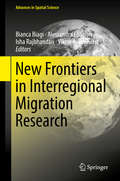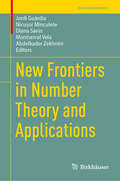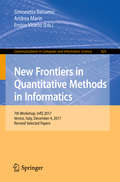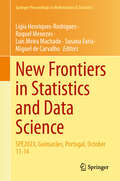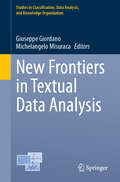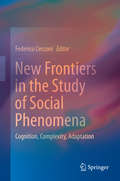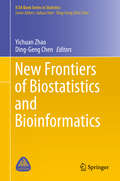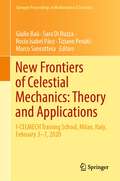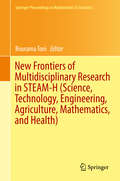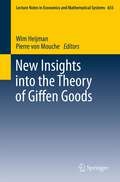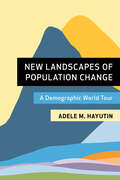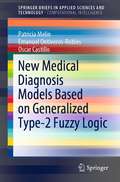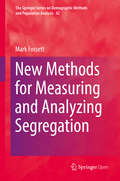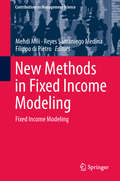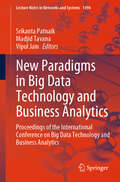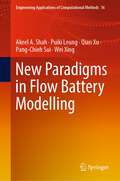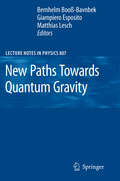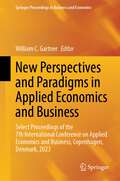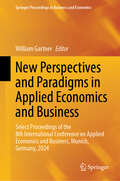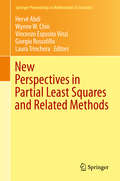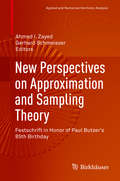- Table View
- List View
New Frontiers in Interregional Migration Research (Advances in Spatial Science)
by Bianca Biagi Alessandra Faggian Isha Rajbhandari Viktor A. VenhorstThis book focuses on the latest advances and challenges in interregional migration research. Given the increase in the availability of "big data" at a finer spatial scale, the book discusses the resulting new challenges for researchers in interregional migration, especially for regional scientists, and the theoretical and empirical advances that have been made possible. In presenting these findings, it also sheds light on the different migration drivers and patterns in the developed and developing world by comparing different regions around the globe. The book updates and revisits the main academic debates in interregional migration, and presents new emerging lines of investigation and a forward-looking research agenda.
New Frontiers in Number Theory and Applications (Trends in Mathematics)
by Jordi Guàrdia Nicuşor Minculete Diana Savin Montserrat Vela Abdelkader ZekhniniThis contributed volume presents recent advances as well as new directions in number theory and its applications. Algebraic and analytic number theory are the main focus with chapters showing how these areas are rapidly evolving. By gathering authors from over seven countries, readers will gain an international perspective on the current state of research as well as potential avenues to explore. Specific topics covered include:Algebraic Number TheoryElliptic curves and CryptographyHopf Galois theoryAnalytic and elementary number theory and applicationsNew Frontiers in Number Theory and Applications will appeal to researchers interested in gaining a global view of current research in number theory.
New Frontiers in Quantitative Methods in Informatics: 7th Workshop, Infq 2017, Venice, Italy, December 4, 2017, Revised Selected Papers (Communications In Computer And Information Science #825)
by Simonetta Balsamo Andrea Marin Enrico VicarioThis book constitutes the refereed proceedings of the 7th Workshop on New Frontiers in Quantitative Methods in Informatics, InfQ 2017, held in Venice, Italy, in December 2017.The 11 revised full papers and the one revised short paper presented were carefully reviewed and selected from 22 submissions. The papers are organized in topical sections on networking and mobile applications; applications of quantitative modeling; big data processing and IoT; theory, methods and tools for quantitative analysis.
New Frontiers in Statistics and Data Science: SPE2023, Guimarães, Portugal, October 11-14 (Springer Proceedings in Mathematics & Statistics #469)
by Lígia Henriques-Rodrigues Miguel De Carvalho Raquel Menezes Luís Meira Machado Susana FariaThis volume showcases a collection of thirty-two peer-reviewed articles presented at the XXVI Congress of the Portuguese Statistical Society (2023). It covers a wide range of cutting-edge topics in both theoretical and applied statistics. Each contribution highlights the latest advancements and research in the field, offering valuable insights and innovative methodologies for researchers and practitioners alike. Readers with a background in mathematics and statistics will find it particularly beneficial, while researchers from various scientific disciplines can explore numerous robust applications.
New Frontiers in Textual Data Analysis (Studies in Classification, Data Analysis, and Knowledge Organization)
by Michelangelo Misuraca Giuseppe GiordanoThis volume presents a selection of articles which explore methodological and applicative aspects of textual data analysis. Divided into four parts, it begins by focusing on statistical methods, and then moves on to problems in quantitative language processing. After discussing the challenging task of text mining in relation to emotional and sentiment analyses, the book concludes with a collection of studies in the social sciences and public health which apply textual data analysis methods.The refereed contributions were originally presented at the 16th International Conference on Statistical Analysis of Textual Data (JADT 2022), which took place in Naples, Italy, on July 6-8, 2022. The biennial JADT meeting discusses theories, problems, and practical uses of textual data analysis in various fields, sharing a quantitative approach to the study of lexical, textual, pragmatic or discursive features of information expressed in natural language.
New Frontiers in the Study of Social Phenomena: Cognition, Complexity, Adaptation
by Federico CecconiThis book studies social phenomena in a new way, by making judicious use of computer technology. The book addresses the entire spectrum of classic studies in social science, from experiments to the computational models, with a multidisciplinary approach. The book is suitable for those who want to get a picture of what it means to do social research today, and also to get an indication of the major open issues. The book is connected to a database of code for simulations, experimental data and allows to activate a subscription to a teaching tool using NetLogo, a programming language widely used in the social studies. The authors are researchers with first-hand experience research projects, both basic and applied. The work will be useful for those who want to understand more of the social, economic and political phenomena via computer applications.
New Frontiers of Biostatistics and Bioinformatics (ICSA Book Series in Statistics)
by Ding-Geng Chen Yichuan ZhaoThis book is comprised of presentations delivered at the 5th Workshop on Biostatistics and Bioinformatics held in Atlanta on May 5-7, 2017. Featuring twenty-two selected papers from the workshop, this book showcases the most current advances in the field, presenting new methods, theories, and case applications at the frontiers of biostatistics, bioinformatics, and interdisciplinary areas.Biostatistics and bioinformatics have been playing a key role in statistics and other scientific research fields in recent years. The goal of the 5th Workshop on Biostatistics and Bioinformatics was to stimulate research, foster interaction among researchers in field, and offer opportunities for learning and facilitating research collaborations in the era of big data. The resulting volume offers timely insights for researchers, students, and industry practitioners.
New Frontiers of Celestial Mechanics: I-CELMECH Training School, Milan, Italy, February 3–7, 2020 (Springer Proceedings in Mathematics & Statistics #399)
by Giulio Baù Sara Di Ruzza Rocío Isabel Páez Tiziano Penati Marco SansotteraThis volume contains the detailed text of the major lectures delivered during the I-CELMECH Training School 2020 held in Milan (Italy). The school aimed to present a contemporary review of recent results in the field of celestial mechanics, with special emphasis on theoretical aspects. The stability of the Solar System, the rotations of celestial bodies and orbit determination, as well as the novel scientific needs raised by the discovery of exoplanetary systems, the management of the space debris problem and the modern space mission design are some of the fundamental problems in the modern developments of celestial mechanics. This book covers different topics, such as Hamiltonian normal forms, the three-body problem, the Euler (or two-centre) problem, conservative and dissipative standard maps and spin-orbit problems, rotational dynamics of extended bodies, Arnold diffusion, orbit determination, space debris, Fast Lyapunov Indicators (FLI), transit orbits and answer to a crucial question, how did Kepler discover his celebrated laws? Thus, the book is a valuable resource for graduate students and researchers in the field of celestial mechanics and aerospace engineering.
New Frontiers of Multidisciplinary Research in STEAM-H (Science, Technology, Engineering, Agriculture, Mathematics, and Health)
by Bourama ToniThis highly multidisciplinary volume contains contributions from leading researchers in STEAM-H disciplines (Science, Technology, Engineering, Agriculture, Mathematics and Health). The volume explores new frontiers in multidisciplinary research, including: the mathematics of cardiac arrhythmia; brain research on working memory; penalized ordinal regression to classify melanoma skin samples; forecasting of time series data; dynamics of niche models; analysis of chemical moieties as anticancer agents; study of gene locus control regions; qualitative mathematical modelling; convex quadrics and group circle systems; remanufacturing planning and control; complexity reduction of functional differential equations; computation of viscous interfacial motion; and differentiation in human pluripotent stem cells. An extension of a seminar series at Virginia State University, the collection is intended to foster student interest and participation in interdisciplinary research and to stimulate new research. The content will be of interest to a broad spectrum of scientists, mathematicians and research students working in interdisciplinary fields including the biosciences, mathematics, engineering, neurosciences and behavioral sciences.
New Insights into the Theory of Giffen Goods
by Wim Heijman Pierre Von MoucheOne might expect that after their identification in the 19th century, all aspects of Giffen goods would have been studied by now. This appears not to be the case. This book contains the latest insights into the theory of Giffen goods. In the past, surprisingly few goods could be categorized as "Giffen." This may be because of a lack of understanding of the character of these goods. Therefore, the theories explained in this book may also produce a solid basis for further empirical research in the field. Experts throughout the world have contributed to this book, which predominantly pursues a mathematically rigorous approach. It may be used by researchers in the field of fundamental economics and in graduate-level courses in advanced microeconomics.
New Landscapes of Population Change: A Demographic World Tour
by Adele M. HayutinDemographic forces—declining populations in many countries and surging populations in others, aging societies, and shrinking workforces—have national, regional, and global reverberations. Behind many of today's news headlines lie critical challenges rooted in worldwide demographic upheaval, with important implications for our future. New Landscapes of Population Change demonstrates how fertility, life expectancy, and migration, the key demographic drivers, interact to shape this future. Hayutin takes readers on a demographic world tour, focusing her analysis on key regions and countries—the largest economies, selected emerging economies, fast-growing populations, and major political hot spots—that will drive pivotal conversations in the decades ahead. More than 100 compelling and easy-to-read charts illustrate striking comparisons that will help readers develop a comprehensive understanding of how demographics will influence economic security and political stability through the end of our century.
New Medical Diagnosis Models Based on Generalized Type-2 Fuzzy Logic (SpringerBriefs in Applied Sciences and Technology)
by Oscar Castillo Patricia Melin Emanuel Ontiveros-RoblesThis book presents different experimental results as evidence of the good results obtained compared with respect to conventional approaches and literature references based on fuzzy logic. Nowadays, the evolution of intelligence systems for decision making has been reached considerable levels of success, as these systems are getting more intelligent and can be of great help to experts in decision making. One of the more important realms in decision making is the area of medical diagnosis, and many kinds of intelligence systems provide the expert good assistance to perform diagnosis; some of these methods are, for example, artificial neural networks (can be very powerful to find tendencies), support vector machines, that avoid overfitting problems, and statistical approaches (e.g., Bayesian). However, the present research is focused on one of the most relevant kinds of intelligent systems, which are the fuzzy systems. The main objective of the present work is the generation of fuzzy diagnosis systems that offer competitive classifiers to be applied in diagnosis systems. To generate these systems, we have proposed a methodology for the automatic design of classifiers and is focused in the Generalized Type-2 Fuzzy Logic, because the uncertainty handling can provide us with the robustness necessary to be competitive with other kinds of methods. In addition, different alternatives to the uncertainty modeling, rules-selection, and optimization have been explored. Besides, different experimental results are presented as evidence of the good results obtained when compared with respect to conventional approaches and literature references based on Fuzzy Logic.
New Methods for Measuring and Analyzing Segregation
by Mark FossettThis book is open access under a CC BY-NC 2. 5 license. This book introduces new methods for measuring and analyzing residential segregation. It begins by placing all popular segregation indices in the "difference of group means" framework wherein index scores can be obtained as simple differences of group means on individual-level residential attainments scored from area racial composition. Drawing on the insight that in this framework index scores are additively determined by individual residential attainments, the book shows that the level of segregation in a given city can be equated to the effect of group membership (e. g. , race) on individual residential attainments. This unifies separate research traditions in the field by joining the analysis of segregation at the aggregate level with the analysis of residential attainments for individuals. Next it shows how segregation analysis can be extended by using multivariate attainment models to assess the impact of group membership (i. e. , the level of segregation for a city) while including controls for other relevant individual characteristics (e. g. , income, education, language, nativity, etc. ). It then illustrates how one can use these models to quantitatively assess the extent to which segregation traces to impacts of group membership on residential attainments versus other factors such as group differences in income. The book then shows how micro-level attainment models can be used to study macro-level variation in segregation; specifically, by estimating multi-level models of individual residential attainments to assess how the effect of group membership (i. e. , segregation index scores) vary with city characteristics. Finally, the book introduces refined versions of popular indices that are free of the vexing problem of upward bias. This improves the quality of segregation measurement directly at the level of individual cases and expanding the number of cases that can be safely included in empirical studies.
New Methods in Fixed Income Modeling: Fixed Income Modeling (Contributions to Management Science)
by Mehdi Mili Reyes Samaniego Medina Filippo Di PietroThis book presents new approaches to fixed income modeling and portfolio management techniques. Taking into account the latest mathematical and econometric developments in finance, it analyzes the hedging securities and structured instruments that are offered by banks, since recent research in the field of fixed incomes and financial markets has raised awareness for changes in market risk management strategies. The book offers a valuable resource for all researchers and practitioners interested in the theory behind fixed income instruments, and in their applications in financial portfolio management.
New Paradigms in Big Data Technology and Business Analytics: Proceedings of the International Conference on Big Data Technology and Business Analytics (Lecture Notes in Networks and Systems #1494)
by Vipul Jain Madjid Tavana Srikanta Patnaik&“New Paradigms in Big Data Technology and Business Analytics&” emphasize the integration of Big Data Technology and Business Analytics enables organizations to transform vast volumes of data into strategic insights, driving smarter decisions, operational efficiency, and innovative growth. This volume presents a comprehensive exploration of the evolving landscape of Big Data Technology and Business Analytics, showcasing transformative approaches that are reshaping industries and research alike. It highlights the integration of advanced tools such as artificial intelligence, machine learning, data mining, and cloud infrastructure to drive intelligent decision-making and operational efficiency. Focusing on both theoretical frameworks and real-world case studies, this book explores into five essential domains: Big Data Infrastructure and Technologies, Data Mining and Machine Learning, Big Data Applications and Case Studies, Business Intelligence and Decision Support, and Data Governance and Ethics. By merging theoretical knowledge with practical applications, this book equips educators, researchers, practitioners, and students with actionable insights into how data-driven strategies can unlock sustainable growth and innovation across sectors. With a forward-thinking vision, it addresses key issues like data privacy, algorithmic fairness, and strategic deployment of analytics in diverse environments. By blending emerging technologies with practical applications, this book serves as a roadmap for anyone aiming to harness the full potential of big data to reshape modern business and society.
New Paradigms in Flow Battery Modelling (Engineering Applications of Computational Methods #16)
by Qian Xu Pang-Chieh Sui Akeel A. Shah Puiki Leung Wei XingThis book provides a comprehensive review of the latest modelling developments in flow batteries, as well as some new results and insights. Flow batteries have long been considered the most flexible answer to grid scale energy storage, and modelling is a key component in their development. Recent modelling has moved beyond macroscopic methods, towards mesoscopic and smaller scales to select materials and design components. This is important for both fundamental understanding and the design of new electrode, catalyst and electrolyte materials. There has also been a recent explosion in interest in machine learning for electrochemical energy technologies. The scope of the book includes these latest developments and is focused on advanced techniques, rather than traditional modelling paradigms. The aim of this book is to introduce these concepts and methods to flow battery researcher, but the book would have a much broader appeal since these methods also employed in other battery and fuel cell systems and far beyond. The methods will be described in detail (necessary fundamental material in Appendices). The book appeals to graduate students and researchers in academia/industry working in electrochemical systems, or those working in computational chemistry/machine learning wishing to seek new application areas.
New Paths Towards Quantum Gravity
by Bernhelm Booß-Bavnbek G. Esposito Matthias LeschAside from the obvious statement that it should be a theory capable of unifying general relativity and quantum field theory, not much is known about the true nature of quantum gravity. New ideas - and there are many of them for this is an exciting field of research - often diverge to a degree where it seems impossible to decide in which of the many possible direction(s) the ongoing developments should be further sustained. The division of the book in two (overlapping) parts reflects the duality between the physical vision and the mathematical construction. The former is represented by tutorial reviews on non-commutative geometry, on space-time discretization and renormalization and on gauge field path integrals. The latter one by lectures on cohomology, on stochastic geometry and on mathematical tools for the effective action in quantum gravity. The book will benefit everyone working or entering the field of quantum gravity research.
New Perspectives and Paradigms in Applied Economics and Business: Select Proceedings of the 7th International Conference on Applied Economics and Business, Copenhagen, Denmark, 2023 (Springer Proceedings in Business and Economics)
by William C. GartnerThis book features a collection of high-quality and peer-reviewed papers from the 2023 7th International Conference on Applied Economics and Business, which was held in Copenhagen, Denmark, during August 24-26, 2023. ICAEB is held annually as a platform for the presentation of new advances and research results in the fields of applied economics and business. Applied economics is a way of dealing with esoteric economic concepts in a practical and analytical way. It allows for decisions to be made that are underlined by theoretical economic principles but utilized in such a way that they transform into real work applications.The contributors cover topics such as environment, development, finance, forensics, information, institutions, international, labor, management, mathematics, currency, tourism and many more. Applied Economics affects all aspects of life and science and it is brought to the forefront in this collection of papers. The conference, with its aim to bring together economists from different fields, lends itself to a natural and rich collection of scientific papers all focused on the practical application of economic principles. The scope of this collection of papers will be useful to academics and practitioners who look to economics to help solve problems.
New Perspectives and Paradigms in Applied Economics and Business: Select Proceedings of the 8th International Conference on Applied Economics and Business, Munich, Germany, 2024 (Springer Proceedings in Business and Economics)
by William GartnerThis book features a collection of high-quality and peer-reviewed papers from the 2024 8th International Conference on Applied Economics and Business, which was held in Munich, Germany during August 23–25, 2024. ICAEB is held annually as a platform for the presentation of new advances and research results in the fields of applied economics and business. This is the third in a series of books based on presented papers. Applied economics is a way of dealing with esoteric economic concepts in practical and analytical ways. It allows for decisions to be made that are underlined by theoretical economic principles but utilized in such a way that they transform into real work applications. Topics of the conference include studies in many fields including environmental, development, financial, forensic, information, institutional, international, labor, managerial, mathematical, monetary, tourism, and many more. Applied economics affects all aspects of life and science, and it is brought to the forefront in this collection of papers. The conference, with its aim to bring together economists from different fields, lends itself to a natural and rich collection of scientific papers all focused on the practical application of economic principles. The scope of this collection of papers will be useful to academics and practitioners who look to economics to help solve problems.
New Perspectives in Partial Least Squares and Related Methods
by Herve Abdi Wynne W. Chin Vincenzo Esposito Vinzi Giorgio Russolillo Laura TrincheraNew Perspectives in Partial Least Squares and Related Methods shares original, peer-reviewed research from presentations during the 2012 partial least squares methods meeting (PLS 2012). This was the 7th meeting in the series of PLS conferences and the first to take place in the USA. PLS is an abbreviation for Partial Least Squares and is also sometimes expanded as projection to latent structures. This is an approach for modeling relations between data matrices of different types of variables measured on the same set of objects. The twenty-two papers in this volume, which include three invited contributions from our keynote speakers, provide a comprehensive overview of the current state of the most advanced research related to PLS and related methods. Prominent scientists from around the world took part in PLS 2012 and their contributions covered the multiple dimensions of the partial least squares-based methods. These exciting theoretical developments ranged from partial least squares regression and correlation, component based path modeling to regularized regression and subspace visualization. In following the tradition of the six previous PLS meetings, these contributions also included a large variety of PLS approaches such as PLS metamodels, variable selection, sparse PLS regression, distance based PLS, significance vs. reliability, and non-linear PLS. Finally, these contributions applied PLS methods to data originating from the traditional econometric/economic data to genomics data, brain images, information systems, epidemiology, and chemical spectroscopy. Such a broad and comprehensive volume will also encourage new uses of PLS models in work by researchers and students in many fields.
New Perspectives on Approximation and Sampling Theory
by Ahmed I. Zayed Gerhard SchmeisserPaul Butzer, who is considered the academic father and grandfather of many prominent mathematicians, has established one of the best schools in approximation and sampling theory in the world. He is one of the leading figures in approximation, sampling theory, and harmonic analysis. Although on April 15, 2013, Paul Butzer turned 85 years old, remarkably, he is still an active research mathematician. In celebration of Paul Butzer's 85th birthday, New Perspectives on Approximation and Sampling Theory is a collection of invited chapters on approximation, sampling, and harmonic analysis written by students, friends, colleagues, and prominent active mathematicians. Topics covered include approximation methods using wavelets, multi-scale analysis, frames, and special functions. New Perspectives on Approximation and Sampling Theory requires basic knowledge of mathematical analysis, but efforts were made to keep the exposition clear and the chapters self-contained. This volume will appeal to researchers and graduate students in mathematics, applied mathematics and engineering, in particular, engineers working in signal and image processing.
New Perspectives on Malthus
by Robert J. MayhewThomas Robert Malthus (1766–1834) was a pioneer in demography, economics and social science more generally whose ideas prompted a new 'Malthusian' way of thinking about population and the poor. On the occasion of the two hundred and fiftieth anniversary of his birth, New Perspectives on Malthus offers an up-to-date collection of interdisciplinary essays from leading Malthus experts who reassess his work. Part one looks at Malthus's achievements in historical context, addressing not only perennial questions such as his attitude to the Poor Laws, but also new topics including his response to environmental themes and his use of information about the New World. Part two then looks at the complex reception of his ideas by writers, scientists, politicians and philanthropists from the period of his own lifetime to the present day, from Charles Darwin and H. G. Wells to David Attenborough, Al Gore and Amartya Sen.
New Prospects in Direct, Inverse and Control Problems for Evolution Equations
by Angelo Favini Genni Fragnelli Rosa Maria MininniThis book, based on a selection of talks given at a dedicated meeting in Cortona, Italy, in June 2013, shows the high degree of interaction between a number of fields related to applied sciences. Applied sciences consider situations in which the evolution of a given system over time is observed, and the related models can be formulated in terms of evolution equations (EEs). These equations have been studied intensively in theoretical research and are the source of an enormous number of applications. In this volume, particular attention is given to direct, inverse and control problems for EEs. The book provides an updated overview of the field, revealing its richness and vitality.
New Sinc Methods of Numerical Analysis: Festschrift in Honor of Frank Stenger's 80th Birthday (Trends in Mathematics)
by Gerd BaumannThis contributed volume honors the 80th birthday of Frank Stenger who established new Sinc methods in numerical analysis.The contributions, written independently from each other, show the new developments in numerical analysis in connection with Sinc methods and approximations of solutions for differential equations, boundary value problems, integral equations, integrals, linear transforms, eigenvalue problems, polynomial approximations, computations on polyhedra, and many applications. The approximation methods are exponentially converging compared with standard methods and save resources in computation. They are applicable in many fields of science including mathematics, physics, and engineering.The ideas discussed serve as a starting point in many different directions in numerical analysis research and applications which will lead to new and unprecedented results. This book will appeal to a wide readership, from students to specialized experts.
New Statistical Developments in Data Science: SIS 2017, Florence, Italy, June 28-30 (Springer Proceedings in Mathematics & Statistics #288)
by Alessandra Petrucci Filomena Racioppi Rosanna VerdeThis volume collects the extended versions of papers presented at the SIS Conference “Statistics and Data Science: new challenges, new generations”, held in Florence, Italy on June 28-30, 2017. Highlighting the central role of statistics and data analysis methods in the era of Data Science, the contributions offer an essential overview of the latest developments in various areas of statistics research. The 35 contributions have been divided into six parts, each of which focuses on a core area contributing to “Data Science”. The book covers topics including strong statistical methodologies, Bayesian approaches, applications in population and social studies, studies in economics and finance, techniques of sample design and mathematical statistics. Though the book is mainly intended for researchers interested in the latest frontiers of Statistics and Data Analysis, it also offers valuable supplementary material for students of the disciplines dealt with here. Lastly, it will help Statisticians and Data Scientists recognize their counterparts’ fundamental role.
